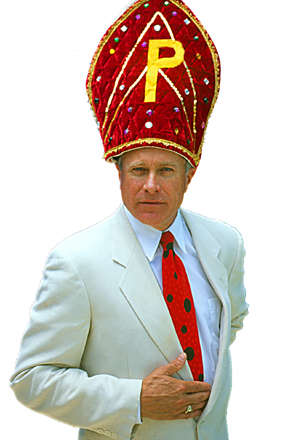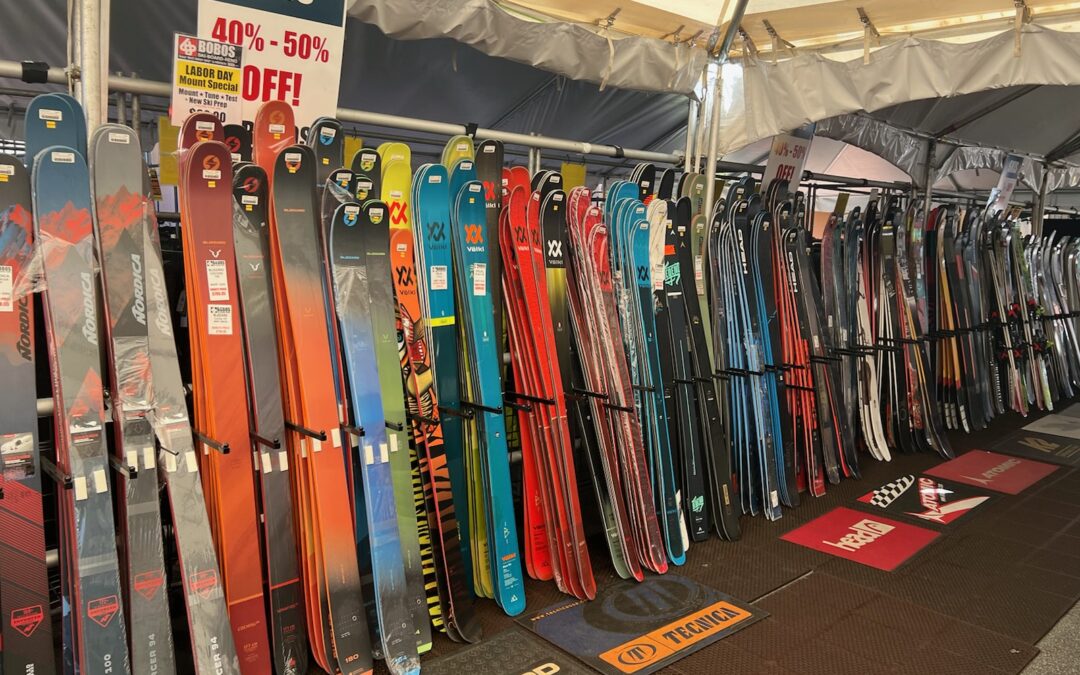
Labor Day marks the beginning of ski season in America. This wall at Bobo’s displays a profusion of carryover, 2022 models. An equal allotment of new models overflow a small armada of ski racks elsewhere under the tent.
Viewed in its totality, the 2023 American Alpine ski market still strives to innovate, but almost all of what is touted as new is an extension of an existing technology or product family, or perhaps embodies a slight construction tweak that doesn’t quite merit the “all-new!” hyperbole.
I’m not alleging that minor changes can’t result in palpable upticks in performance, and gradually extending a proven technology to all members of a product family is standard practice when rolling out new concepts. A handful of “new” models this year are exercises in re-positioning and re-naming carryover models in order to make a particular product family more coherent, or to extend the model family into new territory.
In an era of rising production and distribution costs without commensurate increases in retail pricing, companies benefit from a more coherent collection that can share parts and storytelling details that both reduce costs and improve communication about brand benefits. Spreading a new concept across an entire collection is usually a 3- to 4-year development cycle, extending the various improvements in new technology in affordable doses.
Moving from lofty generalities to nitty-gritty specifics, Rossignol is among the brands that have tightened up their presentation, converting what had been a hodgepodge of designs into two distinct collections, Sender/Rallybird and Blackops. The technology in the unisex Sender and women’s Rallybird family is more consistent, model-to-model, so finding the right ski is easier. The 2023 Blackops clan is a pastiche of the old (the retired Gamer and Holy Shred) and new (Blackops 92) under a single banner, further unified by audacious, arty cosmetics titled Swamp, River, Night and Dusk.
Another brand that brought an unruly line segment to heel is Fischer, that no longer distinguishes between models with or without metal in its venerable, off-trail Ranger series, as all the new Rangers sport a similar patch of Titanal underfoot. In another step towards a more homogenous line, Fischer has not only eradicated the gender divide as far as ski construction is concerned, it no longer even designates any alternative cosmetics as “Women’s Series.”
In the “little things can mean a lot” department, Blizzard slightly slimmed the thickness of its TrueBlend core in the Bonafide 97, Brahma 88 and Brahma 82. The 2023 versions are indeed – however slightly – softer flexing, most discernably the flagship Bonafide, but not to the point that they merit designation as “new.”
Another modest upgrade that seemed to improve performance is a urethane topcoat Head added to its entire off-piste Kore collection. The main intent was to reduce the incidence of scuffing the vulnerable fleece topsheet, but the urethane layer also smoothed out the ride on all but the widest Kores.
The largest quantum leap in performance in a 2023 model over its 2022 incarnation was turned in by K2, where the Mindbender series rocketed up from a so-so ranking last year to near the top of its respective categories for 2023. K2 alleges the changes made to its Y-Beam Titanal laminate were aimed at making these off-trail oriented models more accessible to the less talented, but our on-snow evaluations suggest that it’s the top of the performance range that’s most noticeably affected, all to the better. Regardless which end of the skills spectrum will best appreciate the switch in how the top metal laminate is configured, it’s certain that the overall performance envelope has been considerably expanded.
Völkl validated the praise heaped on its M6 Mantra by extending its signature technologies to its 88mm-waisted clone, the Kendo 88. The name hasn’t changed, but the blending of Tailored Titanal Frame and Tailored Titanal Tips into its 3D Radius Sidecut has elevated what was already the best ski in its genre to new heights.
Where the Action Is
One oddity of the 2023 Alpine ski market is that practically no new models, much less new technologies, can be found in non-race skis narrower than 85mm at the waist. Bucking this nearly monolithic trend are Stöckli’s two-model Montero series, the Montero AX and AR. If these suffixes sound familiar, it’s because this duo replaces the retired Laser AR and Laser AX, two of the best skis ever made. While the new Monteros are a bit wider underfoot, they are in most respects indistinguishable from the Lasers they supplant. My suspicions are that Stöckli wanted to highlight the AX and AR by separating them from the large herd of Lasers that populate its racing families, without alienating their loyal following. The Monteros represent more of a shift in model positioning than ski performance. [Reviews of the new Monteros can be found exclusively on Realskiers.com’s members’ site.]
You’d think deep powder skiing was an everyday event based on where ski makers have introduced the most new models. The Big Mountain (101mm-113mm) genre received the largest infusion of new rides, driven at least in part by the swollen ranks of backcountry skiing novitiates. Now that backcountry skiing has moved closer to the mainstream, ski marketeers are vying to define varying sub-sets of off-trail activities. This season, K2 launches Dispatch, comprised of three Big Mountain models made for skiers who will use any means necessary – including the resort lift system – to get to the goods. In the K2 pantheon, the Dispatch powderhound lives between the in-resort, off-trail Mindbender skier and the ex-resort, exclusively human-powered Wayback skier.
Nordica has similarly inserted the 5-model Unleashed series between its in-resort Enforcers and out-of-bounds Unlimited series. Unequivocally biased towards soft-snow shenanigans, the Unleashed crew has none of the hard-snow chops that characterize Nordica’s all-terrain Enforcers, but are beefier than the featherlight fare that rule the Alpine Touring roost.
Blizzard doubled down on the out-of-bounds, concocting both a new Zero G Light Touring duo and a hurry-uphill trio for the AT aficionado, appropriately titled Hustle. The two new lines complement the returning, 5-model Zero G collection, ensuring that every inch of the backcountry will be tracked up by anyone with an itch to climb.
At the other end of the width/snow-condition scale, racing remains cocooned in its own world, indifferent to trends beyond its realm. As observed in this space previously, the chasm separating the typical recreational skier from the elite racer has never been deeper or wider. There’s a long history of race technology trickling down to the general public, and this pipeline is still in operation, albeit to a lesser degree. The most notable current example is Atomic sharing its race-derived Revoshock dampening system with a citizen-directed, Frontside series dubbed Redster Q.
One reason the world of Alpine racing is so disassociated from the rest of the sport’s practitioners is that the Technical category (67mm – 74mm), that used to form a bridge between race-room technology and elite recreational skiing, has crumbled due to the massive indifference of the American skiing public. While Realskiers.com has always championed the best skis in the Technical genre, it’s become next to impossible to examine the field on snow for the simple reason that there are precious few models available to evaluate.
Prices on the Move
You’d have to be buried under a rock at the back of a cave on a lost continent not to expect prices to go up this year, and they have. But all things considered, not by much. In fact, in some cases the MSRP for a given model may actually go down compared to the list price last year, although the price paid at the register will still be higher.
Huh? This odd scenario is happening because some brands have finally discarded the decades-old practice of publishing a Minimum Advertised Price (MAP) that quickly became the actual selling price in all channels to market. Once manufacturers began competing with their own dealers for the consumer’s dollar, they, too, adopted the MAP price as their de facto retail, meaning even manufacturers no longer used the Manufacturer’s Suggested Retail Price.
When MSRP and MAP are merged into a single price, the old MSRP may very well be lower than the new one, the difference being, no one ever paid the old MSRP but everyone will pay at the new rate, which will be roughly the old MAP, plus $50.
To better understand the mechanics, let’s take a prominent example, the Völkl M6 Mantra, one of the best skis made. Last year was its first on the market, and its list price was $825, on par with the rest of the field. Its street price, however, was the MAP price of $699. The 2023 MSRP is $749.99, a $50 price bump, which will be the norm in almost all instances. Not bad at all, considering that over the last year, the suppliers’ costs for energy and shipping must have increased substantially.
So, the ski market continues to overserve its public, providing an avalanche of choices for skiers of every stripe. At the rate at which the powder seeker – whether a climber or lift-rider – is being besieged with products, there will soon more model choices than we have adequately skilled participants.
Not to mention the glaring irony of devoting so much energy to the creation of fat and ultra-fat skis meant for a condition that seems, by all measures, to be in ever-decreasing supply.

